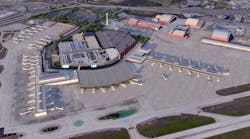... I was struck by how much has changed since the first time I flew out of the facility in 1984. Back then, IAD and Reagan National (DCA) were controlled by the U.S. Congress and a hot issue on Capitol Hill was a proposal to put the two airports under the purview of an independent airport authority. The argument for the move was that an authority independent of Congress could manage and develop the facilities based on local and regional needs, and have the ability to attract capital for development.
At IAD today, the funky and archaic ‘people movers’ that took passengers from the main to remote terminals are all parked away – perhaps awaiting pickup by a dinosaur museum. It was fun seeing the underground Aerotrain that today connects the terminals in operation. I’d had the opportunity a couple of years ago to walk the tunnels then under construction that were the Aerotrain infrastructure. The transformation is nothing short of amazing.
Driving the Dulles Access Road toward the District, one is again struck by the miles of construction for the new Metro rail line that will connect downtown to the airport’s award-winning terminal – once considered a White Elephant and today a major national and international asset.
Once the Metropolitan Washington Airports Authority (MWAA) was created and James Wilding was named to oversee the two airports’ operation and development, he and his crews never looked back. Neither is the same airport it was in 1984, and the nation and system are better for it. Congress, it seems, never should have been in the business of operating commercial U.S. airports.
It’s not unlike the dramatic development that has occurred with Canada’s major airports since the feds there divested themselves of day-to-day operations and put the facilities under the control of local private/public partnerships. Concurrently, the Canadians also privatized their air traffic control system via NavCanada, and as a result they are ahead of the game of modernizing ATC.
The latter point comes to mind as a result of a recent interview I had with Larry Cox, the man who heads up Memphis International. We were talking NextGen and ATC modernization, and Cox made the point that if we had created a privatized system when Canada created NavCanada, the U.S. ATC system would already be modernized. When asked why he thought the U.S. hasn’t taken that route Cox responded, “I don’t think the politicians want to lose control.â€
The minute he said it I recalled the debate in D.C. in the ‘80s over the creation of MWAA. A major point of contention then was the same point – that the politicians didn’t want to lose control. Once that occurred, the change that needed to happen in fact did happen.
Back in the car driving from Dulles, a commercial came on the radio, sponsored by the National Air Traffic Controllers Association (NATCA). The message was about the heroics of a controller and how that moment in time represents how safe the U.S. system remains today, despite the national brouhaha over controllers sleeping or watching movies on the job. That’s in response to the fact that some in Congress, among others, are calling for a rethink of the current system. (In Washington, advertising by lobbying groups such as NATCA is a common way of trying to influence Capitol Hill.)
As I was driving, I could almost feel the irony bouncing off the windows of the rental car.
Thanks for reading. jfi



